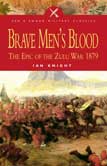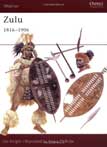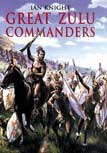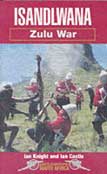

This work is one of the most widley known military campaigns of the Victorian era. The story is presented through the "After the Battle" series "then and now" photographic theme and contains graphic eyewitness accounts from both sides which aim to convey what it was like to give battle in the 1870s. Additional chapters cover what remains to be seen today, both on the battlefields and in museums; the lonely and sometimes unmarked and forgotten graves of the participants; the British forts and their ruins; plus accounts of those film productions that have since been made of the 1879 war.
The Zulu kingdom, created by Shaka kaSenzangakhona, lasted just over six decades before meeting the imperial might of the British Empire. Within six months the kingdom lay in pieces. A full military campaign, known as the Anglo-Zulu War of 1879 was required to ensure its demise. The British High Commissioner in South Africa, Sir Henry Bartle Frere, believed that the robust and economically self-reliant Zulu kingdom was a threat to this policy. In December 1878 he picked a quarrel with the Zulu king, Cetshwayo kaMpande, in the belief that the Zulu army - armed primarily with shields and spears - would soon collapse in the face of British Imperial might. The war began in January 1879. Three columns of British troops under the command of Lt. Gen. Lord Chelmsford invaded Zululand. Almost immediately, the war went badly wrong for the British. On 22 January, the Centre Column, under Lord Chelmsford's personal command, was defeated at Isandlwana mountain. In one of the worst disasters of the Colonial era, over 1300 British troops and their African allies were killed. In the aftermath of Isandlwana, the Zulu reserves mounted a raid on the British border post at Rorke's Drift, which was held by just 145 men. After ten hours of ferocious fighting, the Zulu were driven off. Eleven of the defenders of Rorke's Drift were awarded the Victoria Cross.These are the best-known episodes of the war, and Rorke's Drift inspired the classic film Zulu, which established Michael Caine as a star. However, the author delves deeply into the causes of the war, the conditions during it and the aftermath. Completely re-set, this is one of the most highly-regarded books on the period.
Zulu military organisation was extremely sophisticated. Warriors were organised into regiments with some form of basic uniform and shields were state-manufactured and owned. Yet, in spite of this sophistication, much of the Zulu's military outlook was extremely primitive: firearms were ill understood, and between 1816 and 1906 the Zulus maintained their primary reliance on hand-to-hand fighting. In this book Ian Knight investigates Zulu weaponry in detail, and also their society, beliefs and rituals, particularly with regard to ceremonies conducted before and after battles. Tactics, costume and customs are carefully examined, as are various battles, such as the war between the Zulus and Boers (1838) and the Anglo-Zulu War (1879), which brought about the end of the Zulu kingdom, making this a thorough account of the Zulu warrior.
The Zulus were great warriors, and this book recalls 10 of the most notable ones, from King Shaka to Bambathia Zondi. Each account includes details of Zulu forces, weaponry, tactics and achievements.
Author Ian Knight is almost THE lone voice on the Zulu... few are the books he has not had at least a hand in. This book is unique, because, at last, we get something that looks beyond the Zulu kings (although there are chapters on Shaka and Cetshwayo) and examines some of the men who helped them build the Zulu kingdom.
This book is a great read because it imparts something of the personal lives of the great Zulu warriors, which has been totally ignored by most historians.
The British Army suffered its most severe defeat in Imperial history at the hands of the Zulu impies at Isandhlwana. The author's description of the events on that day brings to life the tragedy for the reader whether at home or on the ground.
Another review said this: The book is small, and covers only the lead up to this epic battle and the battle itself. No real mention of the subsequent Rorke's Drift battle or who escaped from the one only to fight in the other. I suspect this was saved for another book. Lots of low-qual pictures but they do convey the story fairly well. Not a bad book but a bit pricey for what you get.
Boniface V begins his reign as Catholic Pope
Peace of Atrecht
St. Philip of Moscow martyred by Ivan the Terrible
French huguenots declare war on King Louis XIII
Giovanni Cassini discovers Rhea, a satellite of Saturn
English King Jacob II flees to France
Russian / Prussian troops occupy Stralsund
Emperor Charles VI names Maria Elisabeth land guardian of Aust Neth
Prussian Emperor Karel VI sign Treaty of Berlin
France sets plan to tax clergymen
Continental Congress negotiates a war loan of $181,500 from France
Benedict Arnold court-martialed for improper conduct
Thomas Jefferson warned of slave revolts in West Indies
"Visit from St. Nicholas" by C Moore published in Troy (NY) Sentinel
Dutch troops in Antwerp surrender
Joseph Hansom of London receives patent for Hansom cabs
1st Chinese theater in US, Celestial John, opens in San Francisco
Union General Ben "Beast" Butler is proclaimed a "felon, outlaw & common enemy of mankind" by Jefferson Davis
1st self-made millionairess (Sarah Breedlove-hair straightner)
Dutch Painter Vincent van Gogh cuts off his left ear
Field Marshal Lord Roberts departs Southampton to South Africa
Southampton: field marshal lord Roberts departures to South Africa
Tentative Turkish and German treaty on construction of Baghdad railway
1st all-steel passengar railroad coach completed, Altoona, Pennsylvania
Albert becomes King of Belgians
Opera "I Giojelli Della Madonna" is produced (Berlin)
Aswan Dam in Nile begins operation
President Woodrow Wilson signs Federal Reserve Act into law
3 British warships come close to Holland
1st hospital ship built to move wounded naval personnel launched
Alice H Parker patents gas heating furnace
Ireland divided into 2 parts, each with its own parliament
King George V signs Home Rule Act
BBC Radio began daily newscasts
Pope Pius XI pleas for peace: encyclical Ubi arcano
Yankees pitcher Carl Mays sold to Reds for $85,000
Sultan Ibn Saud of Nedzjed conquers Djeddah
KEX-AM in Portland OR begins radio transmissions
NBC sets up a permanent, coast-to-coast radio network
Bette Davis arrives in Hollywood under contract to Universal Studios
Police Bureau of Criminal Alien Investigation started in New York City
Howie Morenz takes over NHL career goal lead at 251
Marinus van der Lubbe sentenced to death
Train crash in Eastern Paris; 230 die
Finnish counter offensive at Summa
South Australia score 7-821 against Queensland
American forces on Wake Island surrender to Japanese
British troops overrun Benghazi Libya
Japan begins assault on Rangoon Burma
Allies air attack on Den Helder
1st telecast of a complete opera (Hansel & Gretel), Schenectady, New York
Gen Montgomery told he is appointed Commandant for D-day
Beginning of harsh winter
Frederick Astons "Cinderella" premieres in London
Pope Pius XII encyclical Orientals omnes, about Rutheense church
Belgian Council of State forms
Highest ridership in NYC subway history (8.8 million passengers)
University of Tennessee refuses to play Duquesne University, because they may use a black player in their basketball game
Transistor invented by Bardeen, Brattain and Shockley in Bell Labs
1st coast-to-coast televised football game (Dumont paid $75,000) LA Rams beat Cleveland Browns 24-17 in NFL championship game
Last Belgian communities get electricity
Dodgers 2nd baseman Jim "Junior" Gilliam wins NL Rookie of Year
"Party with Comden & Green" opens at John Golden NYC for 38 performances
Abdallah Ibrahim forms government of Morocco
King Saudi of Saudi-Arabia takes power
Fidel Castro announces Cuba will release 1,113 prisoners from failed 1961 Bay of Pigs Invasion for $62M worth of food and medical supplies
KICU TV channel 43 in Visalia-Fresno, CA (IND) begins broadcasting
Train accident in Italy, 70 die
Cuba starts returning US prisoners from Bay of Pigs invasion
Dallas Texans beat Houston Oilers 20-17 in AFL championship game
Beach Boys 1st appearance on "Shindig"
Fire on Greek ship Laconia, 128 die
India and Ceylon hit by cyclone, about 4,850 killed
Britains rock TV show, "Ready Steady Go, " last program
Brussels: NATO-Council accept "Flexible Response"-strategy
1st US case of space motion sickness
Borman, Lovell and Anders become 1st men to orbit Moon
North Korea releases Pueblo crew
New York World Trade Center reaches highest point (411 m)
"Immaculate Reception" Steelers turns around a 7-6 defeat with a last second touchdown reception against Raiders to win 13-7
16 plane crash survivors rescued after 70d, survived by cannabalism
6.25 Earthquake destroys central Managua Nicaragua, 10,000 die
Chandrasekhar takes 8-79 India vs. England at Delhi
Islanders end 15 games winless streak
"Young and the Restless" premieres on TV
6 Persian Gulf nations double their oil prices
French Caravelle crashes in Morocco, 106 killed
"Good News" opens at St. James Theater NYC for 16 performances
Congress passes Metric Conversion Act
Peter Seitz makes Andy Messersmith and Dave McNally free agents
Islanders scored 7 goals in 1 period against New York Rangers, Trottier scores 8 points vs. Rangers, 5 goals-NHL record 6 pts in 1 period
New York Islanders greatest shutout lose (8-0) vs. Chicago Black Hawks
Journal Science publishes 1st report on nuclear winter
Rutan andYeager make 1st around-the-world flight without refueling
Lynette "Squeaky" Fromme, serving a life sentence for attempted assassination of President Gerald R Ford escapes from Alderson Prison
"Lettice & Lovage" closes at Barrymore Theater NYC after 284 performances
Slovenians vote to secede from Yugoslavia
New York Daily News publisher Kevin Maxwell resigns
Baseball owners impose salary cap, fiercely opposed by players
4 women ordained priests in Jamaica, 1st in 330-year Anglican history
Chicago Bull coach Phil Jackson is quickest to reach 500 wins (682 games)
Colorado Avalanche Jari Kurri is 8th NHLer to score 600 career goals
Terry Nichols found guilty of manslaughter in Oklahoma bombing
US Agriculture Department estimates it costs $149,820 to raise a child to 18
Woody Allen, 62 weds Soon-Yi Previn 27, adopted Daughter of Mia Farrow




